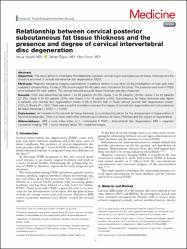Relationship between cervical posterior subcutaneous fat tissue thickness and the presence and degree of cervical intervertebral disc degeneration
Özet
Objective: This study aimed to investigate the relationship between cervical region subcutaneous fat tissue thickness and the
presence and level of cervical intervertebral disc degeneration (IVDD).
Methods: Magnetic resonance imaging examinations of patients referred to our clinic for the investigation of neck pain were
evaluated retrospectively. A total of 300 women aged 30–40 years were included in the study. The presence and level of IVDD
were evaluated for each patient. The cervical subcutaneous fat tissue thickness was also measured.
Results: IVDD was determined as Grade 1 for 88 patients (29.3%), Grade 2 for 56 patients (18.6%), Grade 3 for 82 patients
(27.3%), Grade 4 for 60 patients (20%), and Grade 5 for 14 patients (4.6%). Subcutaneous fat tissue thickness was higher
in patients with cervical disc degeneration (mean: 6.28±0.19mm) than in those without cervical disc degeneration (mean:
5.33±0.18mm) (P = .001). There was a positive correlation between the degree of cervical disc degeneration and subcutaneous
fat tissue thickness ( = 0.001, r = 0.245).
Conclusion: An increase in the cervical fat tissue thickness is a predisposing factor for the development of degeneration of
the intervertebral disc. There is a close relationship between subcutaneous fat tissue thickness and the degree of degeneration.
Abbreviations: BMI = body mass index, IL-1 = interleukin-1, IVDD = intervertebral disc degeneration, MRI = magnetic
resonance imaging, TNF = tumor necrosis factor, WI = weighted images.
Kaynak
Medicine (United States)Cilt
101Sayı
28Bağlantı
https://www.scopus.com/record/display.uri?eid=2-s2.0-85134631846&origin=resultslist&sort=plf-f&src=s&nlo=&nlr=&nls=&sid=20c4fe371b9b908d4f7e419f791331ff&sot=aff&sdt=cl&cluster=scofreetoread%2c%22all%22%2ct&sl=72&s=AF-ID%28%22Alanya+Alaaddin+Keykubat+University%22+60198720%29+AND+SUBJAREA%28MEDI%29&relpos=46&citeCnt=1&searchTerm=https://hdl.handle.net/20.500.12868/2354
https://journals.lww.com/md-journal/fulltext/2022/07150/relationship_between_cervical_posterior.50.aspx


















